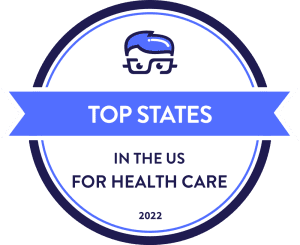Best States for Continuance of Care
MoneyGeek Analysis:
The Best & Worst States for Health Care
Last Updated: 8/11/2022
Advertising & Editorial Disclosure
Quality Verified
Featured Expert s
Access to health care services and the affordability of health insurance are crucial to overall health but vary widely across the United States. MoneyGeek analyzed a host of statistics, from health outcomes — such as preventable deaths and rates of certain diseases or risk factors — to health access and cost — such as how many people are uninsured and have affordable health insurance options available — to find the best and worst states for health care in the U.S.
Summary Findings:
- Hawaii is the top state for health care in the U.S. It has the best health outcomes in the country, with low preventable death (47 per 100,000 people), diabetes mortality and obesity rates. However, the state ranks fairly low for accessibility (No. 31).
- Iowa is the second-best state for health care. Iowans benefit from relatively easy access to health care and relatively low costs. The state ranks No. 7 for affordability.
- West Virginia has the worst health care in the nation. Though West Virginia ranks No. 6 for accessibility, it has the worst health outcomes of any state, with the highest rate of preventable deaths (126 preventable deaths among 100,000 residents) and diabetes mortalities. It also has the highest average private health insurance premiums ($8,546 per year) in the U.S.
- New Mexico has the nation's lowest overall health care costs but ranks No. 48 for accessibility. The state has been slow to alleviate staffing needs to address primary care provider shortages.
- Vermont is the most expensive state for health care. The state has the third-highest annual private health care premiums in the country (averaging $7,886) and government spending on per capita health care costs at nearly $6,000. Vermont spends more than 13% of its total gross domestic product (GDP) on health care, while the national average is around 9%.
- Maryland has the lowest annual private health insurance premiums of any state ($4,052, on average). The national average annual cost across all states in the U.S. is $5,752.
- Massachusetts ranks No. 8 for overall health care. However, the state also has the highest rate of government health care spending in the U.S. at $7,813 per person. That's nearly $3,000 more than the national average and nearly 11% of the state's GDP.
States With the Best (& Worst) Health Care

The states with the best health care in the United States are those where people are generally healthier, have access to health care services and are less likely to be uninsured. The best states for health care are found all across the country, from Hawaii to Rhode Island. That said, 4 of the top 10 states on our list are located in the Northeast.
States that fare worse on our health care rankings tend to have higher costs for less access and higher rates of medical conditions like diabetes and obesity. The worst states for health care are concentrated regionally, with 8 of the 10 clustered in the South and Southeast.
The Top 10 States for Health Care
Scroll for more
The 10 Worst States for Health Care
Scroll for more
Additional Findings: Outcome, Cost & Access Data Rankings
To evaluate health care in the United States, MoneyGeek looked at three categories of data that together create a comprehensive view of the overall quality of health care in each location. Those categories include:
-
Health outcomes, including indicators such as rates of disease and risk factors like obesity and smoking, preventable deaths and infant mortality. These measures help answer the question: How healthy are the people who live here?
-
Cost, including factors like how much the state spends on health care and the average cost of private health insurance. These measures help answer the question: How expensive is health care in this state?
-
Access, including data on the number of primary care providers and hospital beds available, how many people are uninsured and how many people needed care but had difficulty getting it. These indicators help answer the question: How easy is it to get the health care you need in this state?
Within these three categories, we broke down the best and the worst states across a wide range of health care outcome, cost and access data points. Below is a brief summary of those findings, along with the top best and worst states for each data point.
Deep Blue States Across the US Have the Healthiest Residents
1. Hawaii
2. Vermont
3. California
4. Massachusetts
5. New York
1. West Virginia
2. Mississippi
3. Louisiana
4. Tennessee
5. Kentucky
Southern States Have Highest Diabetes Mortality Rates
1. Hawaii: 17.0
2. Massachusetts: 17.2
3. Connecticut: 17.5
4. Vermont: 17.5
5. Colorado: 18.0
50. West Virginia: 41.3
49. Mississippi: 41.0
48. Arkansas: 33.8
47. Louisiana: 33.1
46. Oklahoma: 32.8
West Virginia's Preventable Death Rate Is Nearly 3x Texas's
1. Texas: 44.0
2. Utah: 45.0
3. New York: 45.3
4. Hawaii: 46.5
5. Nebraska: 46.6
50. West Virginia: 125.6
49. Tennessee: 88.7
48. Kentucky: 88.2
47. New Mexico: 88.0
46. Maine: 85.1
Overall Affordability Is Best in the Southwest, Worst in the Northeast
1. New Mexico
2. Colorado
3. Maryland
4. Utah
5. South Carolina
50. Vermont
49. West Virginia
48. New York
47. Massachusetts
46. New Jersey
Health Insurance Is Nearly 2x as Expensive in Worst States for Costs
1. Maryland: $4,052
2. New Mexico: $4,063
3. Minnesota: $4,109
4. Michigan: $4,335
5. Colorado: $4,368
50. West Virginia: $8,546
49. New York: $8,501
48. Vermont: $7,886
47. Wyoming: $7,646
46. New Jersey: $7,000
Access to Care Varies Widely Across Regions
1. Rhode Island
2. Iowa
3. Ohio
4. North Dakota
5. Massachusetts
1. Alaska
2. Texas
3. New Mexico
4. Nevada
5. Georgia
Northeast States Have Lowest Uninsured Rates; Southern States, Highest
1. Massachusetts: 3.0%
2. Rhode Island: 4.1%
3. Hawaii: 4.2%
4. Vermont: 4.5%
5. Minnesota: 4.9%
50. Texas: 18.4%
49. Oklahoma: 14.3%
48. Georgia: 13.4%
47. Florida: 13.2%
46. Mississippi: 13.0%
Northeast States Have 2x the Primary Care Providers of Western States
1. Rhode Island: 255.1
2. Massachusetts: 227.7
3. New York: 207.4
4. Connecticut: 197.8
5. Pennsylvania: 197.0
50. Utah: 98.7
49. Idaho: 99.2
48. Nevada: 101.6
47. Texas: 109.0
46. Montana: 110.3
Expert Insights
Geographic variation in health care costs, access and outcomes is well documented. Some differences are due to local-level conditions and social determinants of health, or non-medical factors that affect health like advantage, isolation and opportunity. The drivers of variation are not predetermined and can be influenced through policy and practice.
MoneyGeek consulted health industry experts to understand some of the potential choices states can make — or are making — to affect their local health care systems for better and worse.
- States vary widely on quality, cost and access measures. To what do you attribute geographic variation in health outcomes and access?
- What could or should states with worse health outcomes and access do to improve health care for their residents?
- Are there principles or best practices for optimizing health spending to optimize outcomes (at the state level or otherwise)?
- Is there anything else you'd like to add about the general phenomenon of geographic variation in health care outcomes, access and cost?

Jay Bhatt
Executive Director, Deloitte Center for Health Solutions

Cyrena Gawuga
Director of Research, Preparedness & Treatment Equity Coalition

Rima Cohen
Special Advisor, Centers for Medicare & Medicaid Services
Full Data Set
The data points presented are defined as follows:
Rank: Based on the "Final Score" ranging from 1-100
Final Score: Cumulative total of Outcome, Cost, and Access scores
- Outcome Factor Rank: Based on cumulative scores across the following factors:
- Infant mortality rate: The number of infant deaths per 1,000 live births
- Preventable death rate: Deaths that can be avoided through effective preventative health care and interventions per 100,000 residents
- Diabetes mortality rate: Deaths attributed to diabetes per 100,000 residents
- Obesity: Percentage of population considered obese
- Smoking rate: Percentage of adults who reported smoking
- Life expectancy: The average number of years a person can expect to live
- Suicide rates: Suicide deaths among persons age 12 and over per 100,000 residents
- New HIV cases per 100,000 residents over the age of 13
- Opioid-related hospital stay rate: Inpatient hospital stays involving opioid-related diagnoses per 100,000 residents
- Cost Factor Rank: Based on cumulative scores across the following factors:
- Health care spending as a percentage of state GDP: Government spending on health care and social assistance out of total state GDP
- State government spending on health care and social assistance per resident
- Average annual private health insurance premium costs
- Access Factor Rank: Based on cumulative score across the following factors:
- Number of hospital beds per 1,000 residents
- Number of primary care providers per 100,000 residents
- Primary care provider shortage areas (HPSAs) by state: Designations that identify areas of the U.S. experiencing health care professional shortages
- Percentage of population with access to any insurance versus just health insurance
- Ease of access to care at the doctor's office or clinic using Medicare
- Ease of access to care at a specialist using Medicare
| State | Rank | Final Score | Outcome Factor Rank (1st = Best) | Cost Factor Rank (1st = Lowest) | Access Factor Rank (1st = Best) |
|---|---|---|---|---|---|
| Alaska | 48 | 33.7 | 32 | 45 | 50 |
| Texas | 26 | 61.2 | 20 | 8 | 49 |
| New Mexico | 44 | 47.2 | 44 | 1 | 48 |
| Nevada | 28 | 60.5 | 22 | 12 | 47 |
| Georgia | 34 | 55.5 | 27 | 16 | 46 |
| Arizona | 41 | 52.7 | 31 | 22 | 45 |
| Oklahoma | 45 | 45.6 | 40 | 13 | 44 |
| Idaho | 24 | 65.8 | 19 | 20 | 43 |
| California | 12 | 80.6 | 3 | 30 | 42 |
| Florida | 39 | 52.9 | 29 | 32 | 41 |
| Wyoming | 31 | 58.0 | 23 | 29 | 40 |
| Utah | 9 | 81.0 | 11 | 4 | 39 |
| Washington | 10 | 80.8 | 9 | 6 | 38 |
| Colorado | 3 | 91.6 | 7 | 2 | 37 |
| North Carolina | 35 | 54.8 | 38 | 15 | 36 |
| Oregon | 19 | 73.1 | 13 | 27 | 35 |
| Montana | 27 | 61.1 | 24 | 33 | 34 |
| Mississippi | 49 | 33.4 | 49 | 14 | 33 |
| Missouri | 42 | 49.9 | 37 | 38 | 32 |
| Hawaii | 1 | 99.0 | 1 | 18 | 31 |
| South Carolina | 29 | 58.8 | 41 | 5 | 30 |
| Delaware | 30 | 58.5 | 28 | 40 | 29 |
| Alabama | 38 | 53.0 | 43 | 17 | 28 |
| Virginia | 15 | 78.8 | 18 | 10 | 27 |
| Connecticut | 17 | 75.5 | 8 | 42 | 26 |
| New Jersey | 16 | 75.9 | 6 | 46 | 25 |
| Maine | 40 | 52.7 | 36 | 43 | 24 |
| Arkansas | 32 | 56.1 | 42 | 11 | 23 |
| Indiana | 36 | 54.6 | 39 | 28 | 22 |
| South Dakota | 37 | 54.0 | 35 | 44 | 21 |
| Maryland | 6 | 82.9 | 21 | 3 | 20 |
| Tennessee | 47 | 38.3 | 47 | 41 | 19 |
| New York | 22 | 71.9 | 5 | 48 | 18 |
| Nebraska | 18 | 75.5 | 14 | 37 | 17 |
| Illinois | 11 | 80.8 | 17 | 21 | 16 |
| Michigan | 21 | 72.6 | 34 | 9 | 15 |
| Kansas | 23 | 67.2 | 33 | 25 | 14 |
| Louisiana | 46 | 44.7 | 48 | 26 | 13 |
| New Hampshire | 7 | 82.1 | 12 | 35 | 12 |
| Pennsylvania | 25 | 65.2 | 30 | 39 | 11 |
| Kentucky | 43 | 48.9 | 46 | 24 | 10 |
| Wisconsin | 20 | 73.0 | 26 | 31 | 9 |
| Minnesota | 4 | 91.1 | 10 | 23 | 8 |
| Vermont | 14 | 79.0 | 2 | 50 | 7 |
| West Virginia | 50 | 1.0 | 50 | 49 | 6 |
| Massachusetts | 8 | 81.3 | 4 | 47 | 5 |
| North Dakota | 13 | 79.9 | 25 | 19 | 4 |
| Ohio | 33 | 55.8 | 45 | 34 | 3 |
| Iowa | 2 | 95.4 | 15 | 7 | 2 |
| Rhode Island | 5 | 85.6 | 16 | 36 | 1 |
Methodology
To explore and rank health care quality by state, MoneyGeek analyzed three core categories — health outcomes, cost and access to care — using health care data from the Kaiser Family Foundation, the Centers for Disease Control and HealthData.gov. We assigned weights to each factor within these core categories to measure health care quality.
MoneyGeek used the following metrics in our analysis:
- Preventable death rate: Full weight
- Infant mortality rate: Full weight
- Life expectancy: Half weight
- Diabetes mortalities per 100,000 people: Half weight
- Obesity as a percentage of the population: Half weight
- Hospital inpatient stays involving opioid-related diagnoses per 100,00 people: Quarter weight
- Smoking rate among adults: Quarter weight
- Suicide deaths among persons ages 12 and older per 100,000 people: Quarter weight
- New HIV cases among persons ages 13 and older per 100,000 people: Quarter weight
- Annual health insurance costs: Full weight
- Health care spending as a percentage of state GDP: Half weight
- Health care spending as a share of GDP per resident: Half weight
- Percentage of population with health insurance: Full weight
- Number of hospital beds per 100,000 people: Half weight
- Adults who had a doctor's office or clinic visit in the last 12 months and needed care, tests, or treatment who sometimes or never found it easy to get the care, tests, or treatment, Medicare fee-for-service: Quarter weight
- Adults who needed to see a specialist in the last 6 or 12 months who sometimes or never found it easy to see a specialist, Medicare fee-for-service: Quarter weight
- Primary care health professional shortage areas: % of need met to remove shortage designation: Quarter weight
- Number of primary care providers per 100,000 population: Quarter weight
If you have any questions about our findings or methodology, please reach out to Melody Kasulis via email at melody@moneygeek.com.
About the Author

Source: https://www.moneygeek.com/insurance/health/analysis/2022-top-states-health-care/
0 Response to "Best States for Continuance of Care"
Enregistrer un commentaire